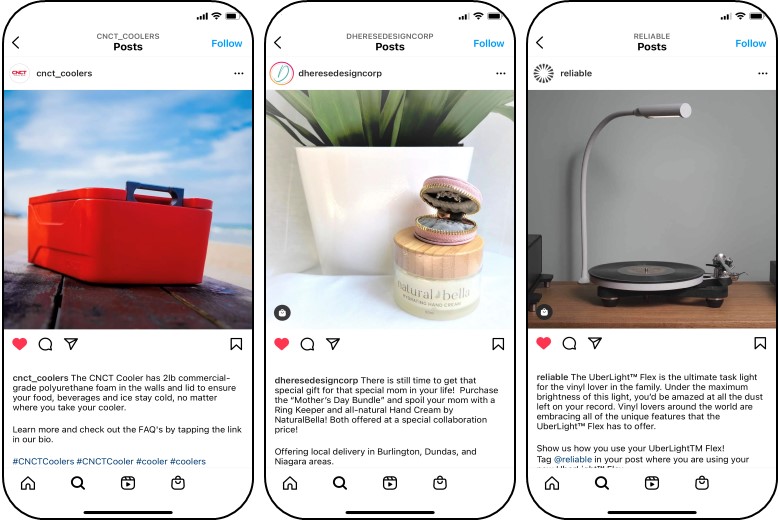Current and former clients know that we’re in the business of helping clients flourish and succeed. So, while our team is developing your product, one of the things we recommend is to start outlining marketing objectives and building a social media following. Yes, I know what you’re thinking. Do new start-ups and invention makers really need social media?
How many of you think social media isn’t worth it? Perhaps you’re thinking, ‘Why go through all the effort to take decent photos, draft witty captions, and pander to an audience in hopes they’ll “like, share, and subscribe” to your content?” If that’s how you feel about social media, take comfort in knowing you’re not the only one who thinks that way. In fact, over 50 per cent of people are not using social media to promote their business, and 25 per cent have no intention of using social media in the future.
Maybe it’s because of your own prejudice that you think all social media content is vapid, meaningless, and a waste of time. Fair, but that may simply mean you’re not the target audience for the content that makes you feel that way.
More likely, however, those feelings of negativity are rooted in the uncertainty of the value you can get from posting on social media. This is also fair. But take some time to sift through the mud. Open minds and keen eyes will catch hidden speckles of words or imagery that glint long enough to tease your curiosity.
The more you keep at it, the more you’ll notice there’s a right way and a wrong way to do social media.

The Goal of Social Media for Home Inventors
For a moment, entertain the thought that building social media content is a legitimate use of your time.
- Would you agree that, as a new inventor or startup, your goal is to increase your customer base?
- Would you agree that generating awareness will help you achieve this goal?
Then by ignoring the 3 billion people using social media across the world, you’re obviously missing out on a huge segment of potential customers. With that number in mind, leveraging social media is a strategy to grow brand awareness and get more potential customers in front of your product.
At this point, you super-skeptics are probably now asking yourself, “How will I know if my content is working?”
Well, that depends on what your objectives are. These are realistic and measurable mini-goals to help you determine if your social media content is working the way you intended or if you need to try some different ideas. Here are some examples of objectives that you might set for yourself:
- Publish three standard posts and one Instagram Reel every week to gain a total of 100 new followers in one month.
- To maintain at least 1000 followers, I will reply to and like ten comments on all my posts for the next year.
Notice how there’s a tactic, target, and timeframe for each objective. By including these three elements, you can start to build, measure, and learn how to create content that resonates with your target audience and will help you generate more potential customers in the future.
The Platforms
As a starting point, you should consider the platforms listed below. There are other exceptionally popular platforms, like Reddit and TikTok, that are a little more difficult to navigate for those new to the social media scene. Be sure to do a little digging on your own to determine what platforms and channels are best suited for your target audience.
- Facebook gets massive traffic but has also seen a slow decline in users over recent years.
- Twitter is fantastic for short, rapid, publicly viewable conversations with your audience. It’s also great for posting copy-driven content like blogs.
- Instagram is currently at the top of the food chain. It is a highly visual platform for sharing photos and video content. You can see some examples below.
- LinkedIn is great for B2B sales but not particularly for B2C businesses if you’re only looking to sell products through this platform. Having a great LinkedIn page, however, will help you establish legitimacy – especially when customers start researching your brand.

Social Media Best Practices
With the ability to reply and like comments, there’s a new layer of connection and interaction that separates social media from other forms of marketing. Here are some best practices to help you make your content great:
- Find a consistent voice: This includes repeating key brand messaging. Whether it’s casual or professional, keep your voice and branding precise, concise, and consistent so as to not confuse your audience.
- Generate a conversation: In your post, don’t be hesitant to ask a question or add a CTA (call to action) to get people talking about your product and brand.
- Engage with your audience: That means taking the time to reply to and like comments and answer questions to build trust as well as robust relationships with your potential and existing customers.
- Be salient: Don’t post irrelevant content like photos of your food or pictures of your pets if it has nothing to do with your product or brand.
- Be a thought leader: Similar to the point above, post content that resonates with your audience so your social media channels become one of the first places they look for information on topics related to your niche.
- Research your competition: What visual elements work well for them? It’s ok to imitate, just don’t copy and paste what they’re doing.
- Post often, post regularly: Many people check their social media accounts more than once a day. Miss a month of posts, and your followers might begin to think you’ve gone out of business.
- Automate your social media: There are great tools, such as Hootsuite and Later, that can help you manage and schedule your posts. You can also track and analyze the performance, reach, and engagement of your social media content.
For tangible examples, you can also take a look at the beautiful content made by our clients Dhérèse, CNCT, and Reliable.
If you have a great new invention and you’d like to learn more about this process, get in touch with MAKO today and visit our website to find out more. Or feel free to give us a call at +1 (888) 806-MAKO, and we can set you up on a call with our product strategist!
To assist our startup and inventor clients, in addition to end-to-end product development, we help with business strategy, product strategy, marketing, and sales/distribution for all consumer product categories.
About: MAKO Design + Invent is the original firm providing world-class consumer product development services tailored to startups, small manufacturers, and inventors. Simply put, we are the leading one-stop-shop for developing your physical product from idea to store shelves, all in a high-quality, cost-effective, and timely manner. We operate as one powerhouse 30-person product design team spread across 4 offices to serve you (Austin, Miami, San Francisco, & Toronto). We have full-stack in-house industrial design, mechanical engineering, electrical engineering, patent referral, prototyping, and manufacturing services. To assist our startup and inventor clients, in addition to above, we help with business strategy, product strategy, marketing, and sales/distribution for all consumer product categories. Also, our founder Kevin Mako hosts The Product Startup Podcast, the industry's leading hardware podcast. Check it out for tips, interviews, and best practices for hardware startups, inventors, and product developers. Click HERE to learn more about MAKO Design + Invent!







